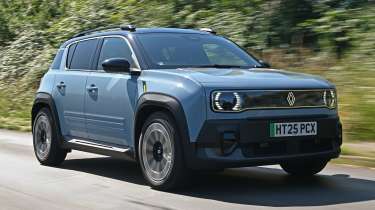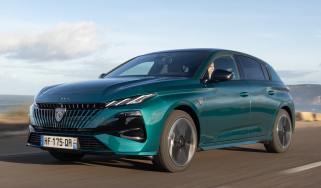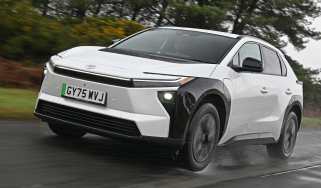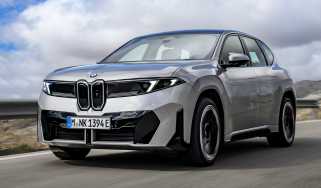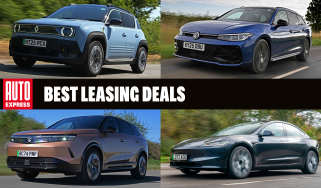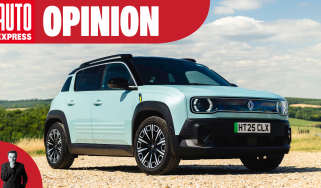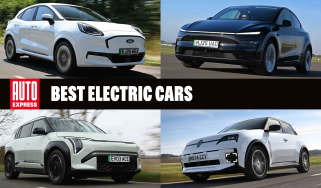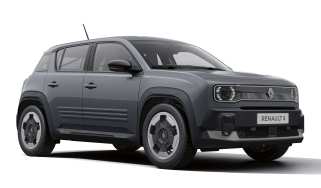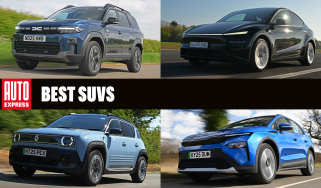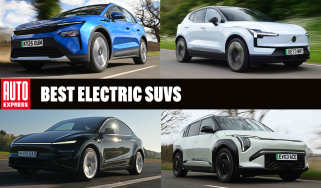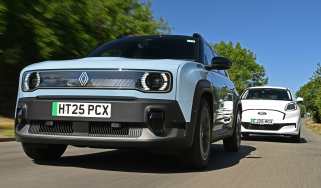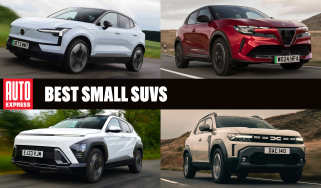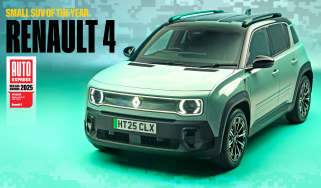Renault 4 review
The Renault 4 isn’t just a more practical R5, it has a unique retro charm all of its own

Our opinion on the Renault 4
Given our glowing reviews of the Renault 5, we had high hopes for the bigger, more practical 4 – and our first drive on UK roads shows the car in its very best light. This is still a small, urban-focused EV, but one that can also serve as a compact family car, capable of occasional long trips. Like its retro sibling, it’s got charm and character by the bucketload; opt for the mid-spec Techno trim and you’ll have one of the best-value new EVs currently on sale.
About the Renault 4
With the arrival of the Renault 4 E-Tech, the French firm has produced a small electric car that’s packed with retro charm. In a way, the R4 is to the Renault 5 E-Tech what the Renault Captur is to the Renault Clio - essentially the same platform and powertrain, but with a unique style and a bit more practicality courtesy of a small SUV-style body.
Of course, there’s much more to the latest R4 than that, with chunky lines and details that draw their inspiration from Renault’s famous budget hatchback introduced in the sixties. The side profile features the same window shape as that original model, and the lines moulded into the doors are another nod to the old R4, while the LED lighting features an illuminated surround and round daytime running lights up front, plus vertical tail-lights inspired by the first R4. These touches are combined with more modern, SUV-derived cues, such as the roof rails and squared-off black wheelarches.
Renault 4 prices and latest deals
The Renault brand is among a growing number of manufacturers that qualify for the Government's Electric Car Grant (ECG) announced in July 2025, and the R4 is eligible for the higher £3,750 'Band 1' grant. You can find the latest top deals on electric cars through the Auto Express marketplace, and our sister brand Carwow has a live EV deals page tracking the latest offers.
If you're interested in getting yourself a Renault 4, we can help. Configure your ideal Renault 4 now to get top offers from local dealers, check out the latest Renault 4 leasing deals with our Find A Car service. You can even sell your existing car for a great price with Auto Express Sell My Car.
Performance & driving experience
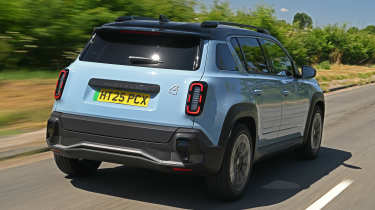
| Pros |
|
| Cons |
|
On the road, the R4 continues to impress. It feels neatly tied down, despite Renault claiming it has a slightly softer set-up than the 5, with a willingness to change direction that’s missing in plenty of its rivals. We mention that softer set-up fleetingly, though; the Renault 4 is still quite stiffly sprung, with a hard-ish edge to the ride around town. Things are much smoother at higher speeds, however.
One thing we particularly like about the 4 compared with every Renault 5 we’ve driven to date, is the introduction of adjustable regen and a one-pedal drive mode. We say ‘to date’, because we’re told that this feature, along with the paddles behind the steering wheel, will be added to the R5 “during its lifecycle”. The system – similar to that found on recent Hyundai and Kia cars – is intuitive to use, and can slow the car to a controlled stop without using the brake pedal at all.
Electric motors, 0-60mph acceleration and top speed
While the 5 comes with two motor options, the 4 just takes the more powerful of the pair. The lone offering sends its 148bhp and 245Nm to the front wheels, delivering decent performance; 0-62mph takes 8.2 seconds, which is more than enough for a car in this class.
It's also more than enough to occasionally overwhelm the front wheels. Torque steer – where the steering wheel squirms a little in your hands under hard acceleration – is noticeable at times, without having a detrimental effect on the driving experience. The Renault 4, like its smaller sibling, is really good fun to drive.
Yet it can do the relaxing stuff pretty well, too; knock it from Sport into Comfort, and you’ve still got enough power to surge away from junctions or traffic lights. However, Eco pegs things back significantly – to the extent that you may struggle to maintain a steady speed on steeper inclines. We’d leave that mode for when you really need to maximise efficiency.
| Model | Power | 0-62mph | Top speed |
| 4 E-Tech | 148bhp | 8.2s | 93mph |
Range, charging & running costs
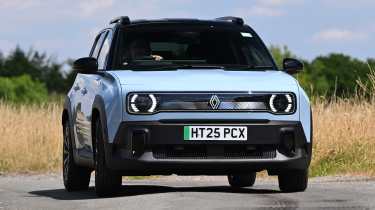
| Pros |
|
| Cons |
|
Electric range, battery life and charge time
The Renault 4’s extra size relative to the R5 has only slightly dented the overall range. Officially, the R4 can cover up to 247 miles between charges – just five miles short of what the R5 can achieve.
We saw 3.8mi/kWh over a mixture of roads – including stop-start London traffic, a long run up the motorway and some more enthusiastic driving on our favourite rural roads. That equates to just shy of 200 miles on a full charge, and we reckon a more considered driving style would see you get much closer to the car’s stated WLTP range. It largely tallies with what the R5 can achieve in similar conditions, and in our hands, that car managed 4.1miles/kWh in more mixed conditions.
Charging speeds are less impressive, but pretty much par for the course in this part of the new-car market. Renault claims a 100kW peak – identical to those of the Ford Puma Gen-E and the various Stellantis compact SUVs, plus marginally quicker than the MINI Aceman’s. But we saw no more than 65kW on a 150kW charger, having plugged in at around 40 per cent. It maintained this speed pretty consistently to almost 80 per cent, however, which was good to see. Charging at home using a typical 7.4kW wallbox charger will take just under eight hours to fully recharge a Renault 4.
One smart feature of the charging system on the Renault 4 is that it has a vehicle-to-load capability. This means you can plug an adaptor into the car's charging port and charge or run external devices. The power source is rated at 3.7kW.
| Model | Battery size | Range | Insurance group |
| 4 E-Tech | 52kWh | 247 miles | 27 |
Insurance groups
There are three versions of the Renault 4, but they only fall into two insurance groups. The Evolution model is in group 28, while the higher-spec Techno is in 27 (likely to be a group lower because front parking sensors are added), and the range-topping Iconic is also in group 28. These groups are all a little high, especially when you consider the Puma Gen-E is in groups 18 and 19.
Tax
The all-electric powertrain helps keep running costs low for business users, while the affordable pricing of the R4 means road tax isn’t affected by the £40,000 luxury car tax premium. You will still have to pay the standard rate of annual vehicle excise duty (VED), because EVs are no longer exempt from it.
Company car drivers will benefit from a low benefit-in-kind (BiK) rate of just three per cent, rising to four per cent from 2026.
Depreciation
The R4 is expected to retain between 51 and 53 per cent of its original value over three years or 36,000 miles, which is pretty good for a small electric SUV. In comparison, the Puma Gen-E is lower in the 42 per cent ballpark, while the MINI Aceman has residuals of between 48 and 53 per cent.
To get an accurate valuation for a specific model, try our free car valuation tool...
Interior, design & technology

| Pros |
|
| Cons |
|
Renault is on a bit of a roll at the moment with its designs. From the modern-looking Renault Scenic and the neat facelifts of the Clio and Captur, to the retro-modern charm of the Renault 5, there is plenty of good styling coming out of the French firm. The Renault 4 is no different, and judging by the sideways glances and looks of admiration we received when driving the car on its European launch, this reimagination of one of the French brand’s most famous past hits looks set to be a popular one.
There are three trim levels to choose from – Evolution+, Techno+ and Iconic+ – and kit levels are generous from the bottom up. All cars get the 10.1-inch touchscreen, a reversing camera and rear parking sensors, keyless entry and a heat pump.
We’d opt for the mid-spec Techno+ because it adds desirable styling elements such as roof bars, wireless phone charging, privacy glass, ambient lighting, and a bigger digital instrument cluster. If you can do without the flagship Iconic+’s two-tone paint, heated seats and steering wheel, power tailgate and extra safety features, it’s definitely the pick of the R4 range.
Interior and dashboard design
The 4’s dashboard and infotainment system are an almost wholesale carryover from the R5, which is no bad thing. While we’d often cry out for a little more individuality between two models which look so different on the outside, the R5’s fantastic cabin is a pretty strong starting point.
Drivers get a funky-looking dash, which feels as expensive as anything else in the class, and has been designed with some genuine thought to usability. The climate controls take the form of a bank of physical switches lower down on the dash, which are super easy to use and operate with a lovely tactility.
Materials and build quality
The materials used are mostly very good, with the exception of some scratchier plastics lower down, and a cheap-feeling lid to the small bin in the centre console. The seats are comfortable – apparently with different padding to the 5 – and the squared-off bonnet makes it easy to place the car when parking.
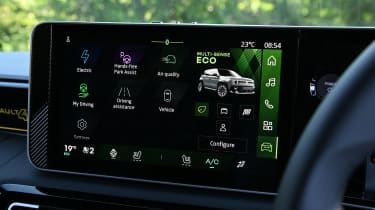
Infotainment, sat-nav and stereo
The dual-screen layout is clear and easy to read, while the Google-based software is intuitive and filled with functionality – including Google Maps with built-in EV routing. The beeps and bongs for the driver-assistance systems are quite loud, not to mention a little odd-sounding – the speed-limit warning has a strange Doppler effect, for example, changing frequency as it chimes. Of course, Renault’s wonderfully simple ‘My Perso’ button means you can switch off everything you don’t want at the flick of a switch.
“The Renault 4 draws inspiration from the company’s back catalogue, but the E-Tech model is light years ahead in terms of quality. While the dashboard layout is identical to the R5’s, the separate climate controls and stubby infotainment control stalk on the steering column will also be familiar to anyone who’s driven a modern Renault.” – Alex Ingram, chief reviewer
Boot space & practicality
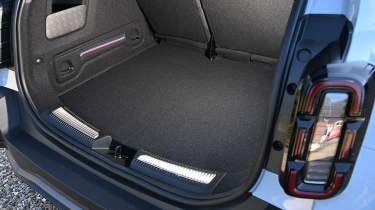
| Pros |
|
| Cons |
|
The retro-themed Renault 5 has dominated headlines as one of the most stylish small cars since its launch late last year. But if truth be told, we’ve been holding out for its still-smart Renault 4 sibling, with one eye fixed on the R5’s biggest failing: its compromised practicality.
Sure, the 5’s got a decent boot for something so compact, and there’s enough room up front for taller adults to get comfy. But force your friends into the rear, and unless they’re trained contortionists, they’ll not be thanking you for anything longer than a short hop to the shops.
Dimensions and size
At 4.1 metres long, the R4 is no giant SUV – its dimensions are within millimetres of the Ford Puma in every direction – but that also means it’s 222mm longer than the Renault 5, and 83mm of that increase sits between the front and rear axles, so interior space is boosted.
| Dimensions comparison | |||
| Model | Renault 4 | Ford Puma | MINI Aceman |
| Length | 4,144mm | 4,186mm | 4,079mm |
| Width | 1,808mm (2,020mm inc mirrors) | 1,805mm (1,930mm inc mirrors) | 1,754mm (1,991mm inc mirrors) |
| Height | 1,552mm | 1,536mm | 1,514mm |
| Wheelbase | 2,624mm | 2,588mm | 2,606mm |
| Boot space | 339-1,113 litres | 556-1,283 litres | 300-1,005 litres |
Seats & passenger space
Overall, the Renault 4’s interior is a pleasant place to be. The seats are comfortable and the layout is easy to get along with, while there’s a wide range of wheel and seat adjustment on offer, too.
We have one or two minor gripes, though. The column-mounted gear selector is a little easy to confuse with the wiper stalk during parking manoeuvres, causing some inadvertent windscreen swipes rather than a change in direction, while the rear quarter windows are pretty much useless, so there’s a reasonable blind spot over the shoulder. On the plus side, the squared-off bonnet helps with positioning the front of the car in tight spots.
The Renault 4 gets a bit more head and legroom in the back than the R5, thanks to its boxier SUV shape – there’s more room here than in a MINI Aceman or Jeep Avenger. There’s still not very much space under the front seats for your feet, and the high floor means it’s short of under-thigh support, but overall, there’s just about enough room for those approaching six feet tall not to feel too hemmed in. It’s just a shame our car’s dark interior doesn’t add to that sense of space.
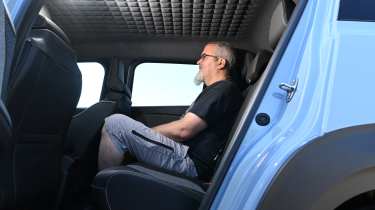
Boot space
The R4's boot capacity is bigger than the R5’s; 339 litres with the seats up rising to 1,113 litres with the 60/40 split rear seats folded down. There isn't space under the bonnet for the charging cables, but you will find a 55 litre hidden cavern under the floor. The load lip is particularly low, and there is no step to haul things over, but the trade-off is a frankly huge tailgate that, on a number of occasions, meant parking slightly further away from a wall than we might have liked. You’ll need quick reactions if you want to avoid damaging the electrically operated bootlid on top-spec Iconic cars, too.
“If you’re looking for more storage under the bonnet to keep a charging cable or suchlike, you’re out of luck, because that’s where the electric powertrain resides.” – Alex Ingram, chief reviewer
Reliability & safety
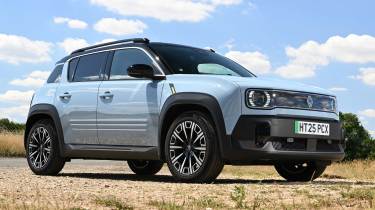
| Pros |
|
| Cons |
|
Since the Renault 4 shares so much with the Renault 5, it shouldn’t come as a surprise to learn that it earned the same four-star Euro NCAP rating as the supermini. As with that car, the score was pegged back by the lack of a centre airbag between the front seats, plus the fact that the dashboard couldn’t demonstrate the same level of protection for occupants of different sizes.
Get past the Euro NCAP score, and there are plenty of positives in terms of standard safety kit, with automatic emergency braking capability in both forward and reverse, lane-departure warning and emergency lane-keeping assistance included. However, you have to upgrade to the top-spec Iconic model for blind-spot warning and safe-exit assistance, the latter helping to prevent you from opening the door into the path of approaching vehicles.
Speed-limit warning systems are now mandated to be active every time you start a car, but Renault makes it easy to disable the R4’s with the touch of a button. The My Perso mode can be set up via the touchscreen, then all you need to do to have the warning systems set up the way you like them is to press the My Safety button on the dashboard.
The Renault brand leapt from 28th out of 30 manufacturers in the 2024 Driver Power customer satisfaction survey, to sixth out of 31 in the latest 2025 results. That's a big improvement over previous years, with respondents rating low running costs, the infotainment system's ease of use, the safety features, exterior styling, and value for money amongst their favourite parts of their cars. The brand still needs to work on practicality, ride quality, and overall reliability, though.
| Euro NCAP safety ratings | |
| Euro NCAP safety rating | Four-stars (2024) |
| Adult occupant protection | 79% |
| Child occupant protection | 85% |
| Vulnerable road user protection | 73% |
| Safety assist | 68% |
Buying and owning
Best buy: Renault 4 E-Tech Techno
All models offer good value, but the extra front parking sensors, one-pedal driving and adaptive cruise that come with the mid-spec model make it our choice.
The Renault Megane and Renault Scenic EVs come with a four-year powertrain warranty on top of the standard three-year manufacturer warranty, but the Renault 4 (like the R5) only has a three-year powertrain warranty. The mileage limit remains 100,000 miles, though.
Prices for service plans are still to be announced for the R4, but we expect them to be similar to the around £10 per month it costs to get a three-year/48,000-mile EasyLife service plan for the Renault Scenic.
Renault 4 alternatives
The pricing of the Renault 4 works out pretty favourably against rivals such as the Ford Puma Gen-E and MINI Aceman. The Ford’s interior ergonomics, quality and infotainment tech aren’t a patch on the Renault’s, and while the MINI has a stunning interior design, it's hampered by a ride that's too firm, a cabin that's too cramped, and poor electric driving range when compared with the R4.
Deals on the Renault 4 and alternatives
Renault 4 pictures
Frequently Asked Questions
Definitely. We were fans of the new Renault 5, and the R4 manages to build on that car’s talents by adding more space and an equally smart retro-inspired body. Sure, it’s nothing like the old Renault 4 in concept, but it still has plenty of appeal.

